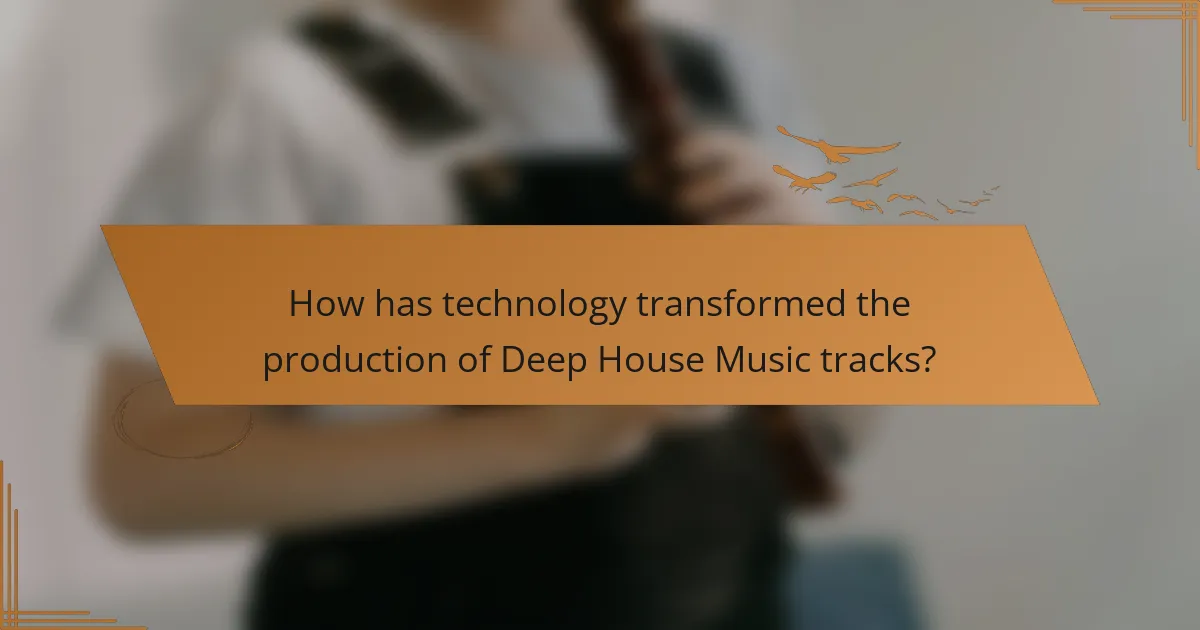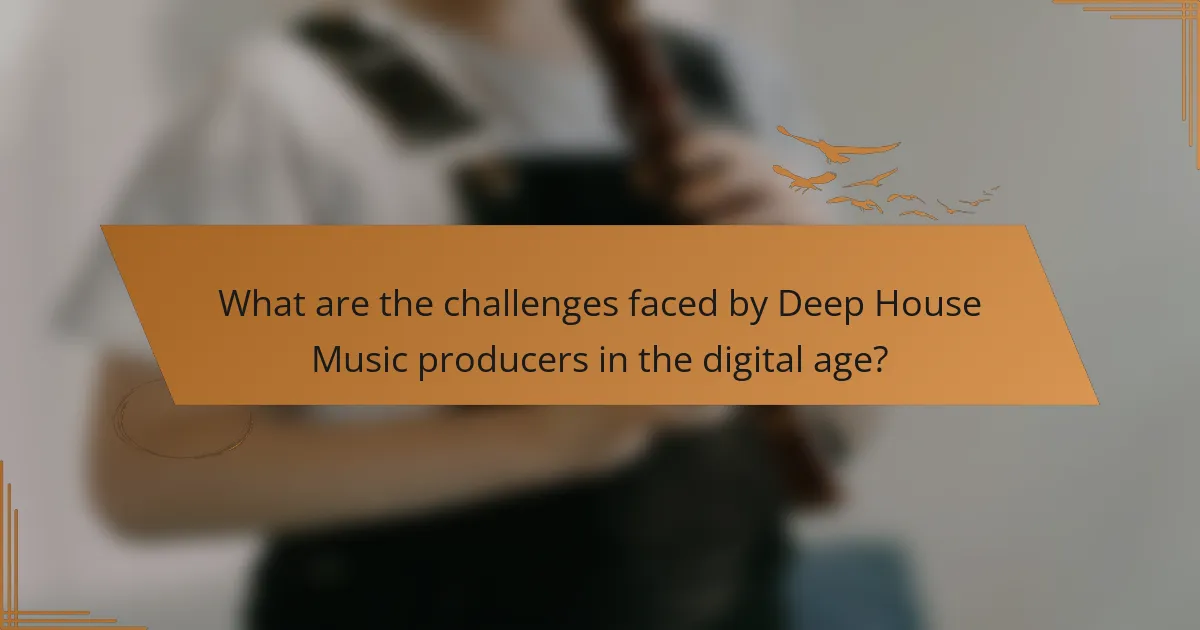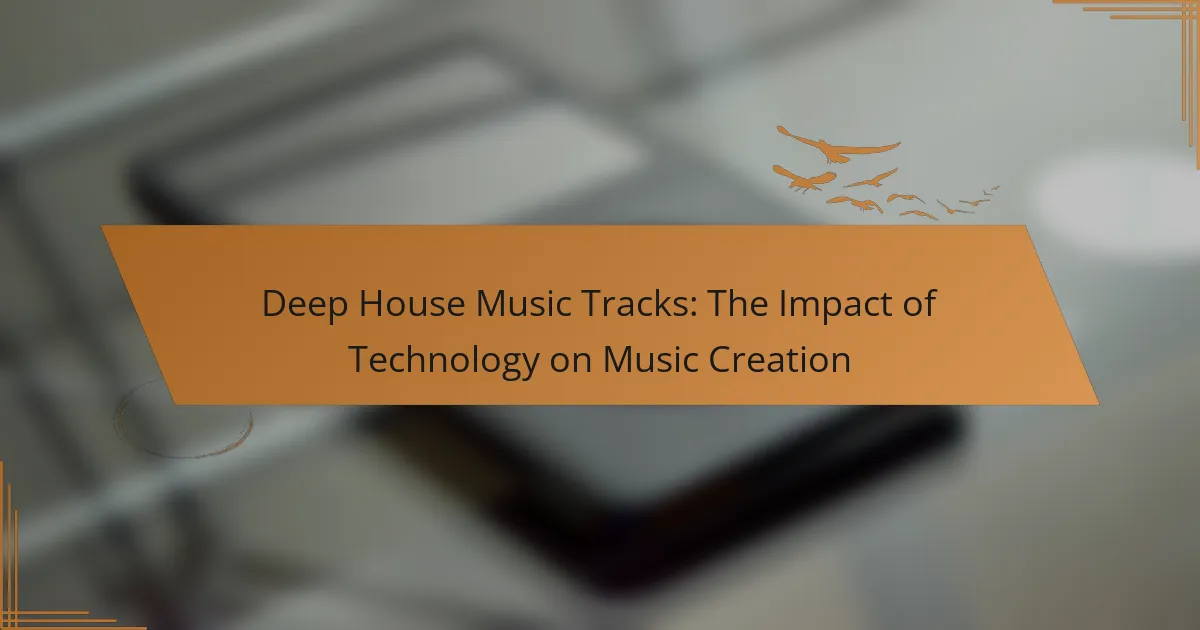Deep house music is a subgenre of house music characterized by its soulful melodies and slower tempos, typically ranging from 120 to 125 beats per minute. Emerging in the 1980s and influenced by jazz, soul, and funk, deep house incorporates intricate chord progressions and smooth vocals, creating a relaxed atmosphere. The article explores the significant impact of technology on the production of deep house tracks, highlighting advancements such as Digital Audio Workstations (DAWs), software synthesizers, and MIDI technology that have transformed the music creation process. It also addresses the challenges faced by producers in a saturated market, including competition, the need for originality, copyright issues, and audience engagement on social media.

What is Deep House Music?
Deep house music is a subgenre of house music known for its soulful and melodic elements. It typically features slower tempos, ranging from 120 to 125 beats per minute. Deep house incorporates intricate chord progressions and smooth vocals, creating a relaxed atmosphere. The genre emerged in the 1980s, influenced by jazz, soul, and funk. Notable artists include Larry Heard and Kerri Chandler, who helped shape its sound. Deep house music often utilizes synthesizers and drum machines, showcasing the impact of technology in music creation. This subgenre has gained popularity in clubs and festivals worldwide, reflecting its broad appeal.
How did Deep House Music originate?
Deep House Music originated in the 1980s, primarily in Chicago. It evolved from house music, incorporating elements of jazz, soul, and funk. Pioneering artists like Larry Heard and Frankie Knuckles played key roles in its development. The genre is characterized by its use of smooth, deep basslines and atmospheric sounds. The introduction of synthesizers and drum machines facilitated its unique sound. Deep house gained popularity in clubs and underground scenes. By the 1990s, it spread to Europe, influencing various subgenres. Today, it remains a significant part of electronic dance music culture.
What are the defining characteristics of Deep House Music?
Deep House Music is characterized by its mellow, soulful sound and complex melodies. It typically features a slower tempo, often ranging from 120 to 125 BPM. The genre includes deep basslines that provide a smooth foundation. Vocals in deep house are often soft and emotive, contributing to the overall atmosphere. Chord progressions are rich and jazzy, enhancing the musical depth. Additionally, deep house incorporates elements of funk and ambient music, creating a unique sonic experience. The use of synthesizers and electronic instruments is prevalent, showcasing technology’s impact on music creation. These characteristics have made deep house a popular genre in clubs and lounges since its emergence in the 1980s.
How has the evolution of Deep House Music influenced its current form?
The evolution of Deep House Music has significantly influenced its current form by integrating diverse musical elements. Initially rooted in Chicago house music, it incorporated soulful vocals and jazz influences. This blend created a distinct sound characterized by deep basslines and atmospheric melodies. Over time, the genre embraced technology, utilizing synthesizers and digital audio workstations for production. The rise of online platforms allowed for greater accessibility and experimentation within the genre. Notable artists like Larry Heard and Kerri Chandler contributed to its development, solidifying its unique identity. Today, Deep House continues to evolve, reflecting contemporary trends while maintaining its foundational characteristics.
What role does technology play in Deep House Music creation?
Technology plays a crucial role in Deep House Music creation. It enables artists to produce, mix, and master tracks with precision. Digital Audio Workstations (DAWs) like Ableton Live and FL Studio are essential tools. They provide a platform for arranging and editing sounds efficiently. Synthesizers and drum machines create unique sounds that define the genre. Software plugins enhance audio quality and add effects. Sampling technology allows the incorporation of diverse musical elements. Additionally, online collaboration tools facilitate remote teamwork among artists. According to a 2021 survey, over 80% of Deep House producers use technology for music creation.
What technological tools are commonly used in producing Deep House tracks?
Digital Audio Workstations (DAWs) are commonly used in producing Deep House tracks. Popular DAWs include Ableton Live, FL Studio, and Logic Pro. These tools allow for multi-track recording and editing. Synthesizers are also essential in Deep House production. Hardware synths like the Moog Sub 37 and software synths like Serum are frequently utilized. Drum machines, such as the Roland TR-808, provide characteristic beats. Effects plugins, including reverb and delay, enhance sound depth and texture. MIDI controllers facilitate live performance and composition. These tools collectively shape the unique sound of Deep House music.
How do software and hardware innovations enhance the sound of Deep House Music?
Software and hardware innovations enhance the sound of Deep House Music by providing advanced tools for sound design and production. Digital audio workstations (DAWs) allow for intricate layering and manipulation of sounds. Synthesizers create rich, textured basslines characteristic of the genre. High-quality audio interfaces improve sound clarity and fidelity. Plugins offer a range of effects, such as reverb and compression, that shape the overall mix. MIDI controllers enable precise control over virtual instruments and effects. Innovations in sampling technology allow for unique soundscapes and loops. These advancements collectively contribute to a more dynamic and immersive listening experience in Deep House Music.

How has technology transformed the production of Deep House Music tracks?
Technology has significantly transformed the production of Deep House Music tracks. Digital Audio Workstations (DAWs) allow producers to create, edit, and mix music efficiently. Software synthesizers and plugins offer a vast range of sounds and effects. This accessibility has democratized music production, enabling more artists to create tracks. MIDI technology facilitates precise control over musical elements. Sampling technology allows for the incorporation of diverse sounds into compositions. Additionally, online platforms provide avenues for distribution and collaboration. The integration of artificial intelligence in music production is also emerging, further enhancing creativity. These advancements have reshaped the landscape of Deep House Music, making it more innovative and varied.
What are the latest advancements in music production technology?
Recent advancements in music production technology include the rise of artificial intelligence in music composition. AI tools can analyze vast amounts of data to create unique melodies and rhythms. Additionally, cloud-based collaboration platforms have improved remote teamwork among musicians and producers. These platforms allow real-time editing and sharing of projects, enhancing productivity.
Virtual reality is also making its mark in music production. It offers immersive environments for artists to create and perform. Moreover, advancements in digital audio workstations (DAWs) provide more intuitive interfaces and powerful plugins. These tools streamline the production process and enhance sound quality.
Lastly, hardware innovations, such as advanced synthesizers and drum machines, are pushing the boundaries of sound design. These devices offer unprecedented flexibility and creativity in music production.
How do digital audio workstations (DAWs) impact Deep House Music production?
Digital audio workstations (DAWs) significantly enhance Deep House Music production. They provide a versatile platform for creating, editing, and mixing tracks. DAWs allow producers to manipulate audio with precision. Features like MIDI sequencing facilitate the arrangement of complex rhythms and melodies. Producers can also utilize a wide range of virtual instruments and effects. This flexibility encourages creativity and experimentation in sound design. Advanced editing tools enable quick adjustments to audio elements. Consequently, DAWs streamline the production process, making it more accessible to aspiring artists.
What role do synthesizers and samplers play in creating Deep House sounds?
Synthesizers and samplers are essential tools in creating Deep House sounds. Synthesizers generate a wide range of electronic sounds, allowing producers to craft unique melodies and basslines. They can emulate traditional instruments or create entirely new tones, contributing to the genre’s rich sonic palette. Samplers, on the other hand, manipulate pre-recorded audio samples. They can incorporate vocal snippets, drum hits, and other sounds to add texture and depth to tracks.
The use of synthesizers allows for the creation of lush chords and atmospheric pads, which are characteristic of Deep House. For example, popular synthesizers like the Roland Juno-106 or Serum are frequently used for their warm, rich sounds. Samplers like the Akai MPC series enable producers to layer sounds and create intricate rhythms, enhancing the groove that Deep House is known for.
Together, these tools facilitate experimentation and innovation within the genre. They enable artists to push creative boundaries, resulting in diverse and evolving Deep House music.
How do online platforms influence the distribution of Deep House Music?
Online platforms significantly influence the distribution of Deep House Music by providing accessible channels for artists and listeners. These platforms, such as Spotify and SoundCloud, allow artists to upload and share their tracks globally. This accessibility enables independent artists to reach wider audiences without traditional record label support.
Additionally, algorithms on these platforms recommend music based on user preferences, promoting new artists and tracks. Data from Spotify shows that over 60% of users discover new music through curated playlists. Social media also plays a crucial role in promoting Deep House artists and events, further enhancing visibility.
The rise of digital streaming has led to a shift from physical sales to online consumption. According to the International Federation of the Phonographic Industry (IFPI), global music streaming revenue grew by 19.9% in 2020. This trend highlights how online platforms are reshaping the landscape of music distribution.
What are the benefits of streaming services for Deep House artists?
Streaming services provide significant benefits for Deep House artists. They offer a platform for wider audience reach. Artists can distribute their music globally with minimal effort. This accessibility increases potential fan engagement. Streaming platforms also provide valuable analytics. These insights help artists understand listener preferences. Additionally, artists can earn revenue through streaming royalties. According to the Recording Industry Association of America, streaming accounted for 83% of the music industry’s revenue in 2020. This financial support can be crucial for independent Deep House artists. Overall, streaming services enhance visibility and financial opportunities for Deep House musicians.
How does social media contribute to the promotion of Deep House tracks?
Social media significantly enhances the promotion of Deep House tracks. Platforms like Instagram, Facebook, and Twitter allow artists to share their music directly with fans. This direct engagement fosters a sense of community around the genre. Additionally, social media algorithms can amplify reach, making tracks discoverable to a wider audience. For instance, artists can use hashtags related to Deep House to attract listeners. User-generated content, such as dance videos or remixes, further promotes tracks organically. According to a 2021 study by the International Music Summit, 70% of electronic music fans discover new music through social media. This statistic underscores the effectiveness of these platforms in music promotion.

What are the challenges faced by Deep House Music producers in the digital age?
Deep House Music producers face several challenges in the digital age. One significant challenge is the saturation of the market. With the rise of digital distribution, many producers can release music easily. This leads to intense competition. Another challenge is the constant evolution of technology. Producers must stay updated with new software and hardware. This can be time-consuming and costly. Additionally, maintaining originality is difficult. Many tracks may sound similar due to common production techniques. Producers also face challenges with copyright issues. Digital platforms can complicate the protection of original work. Finally, engaging with audiences on social media requires consistent effort. Building a loyal fan base takes time and strategy. These challenges impact the creative process and business success.
What common pitfalls do producers encounter with technology?
Producers commonly encounter several pitfalls with technology. One significant issue is over-reliance on software. This can lead to a lack of creativity as producers depend too heavily on presets. Another pitfall is inadequate understanding of the tools. Many producers fail to fully utilize the features of their software and hardware. This results in suboptimal sound quality and production efficiency. Additionally, technical issues often arise, such as software crashes or hardware malfunctions. These disruptions can halt the creative process and lead to lost work. Lastly, producers may struggle with sound design, leading to generic-sounding tracks. This can diminish the uniqueness of their music.
How can producers ensure quality in a digitally dominated landscape?
Producers can ensure quality in a digitally dominated landscape by utilizing advanced digital audio workstations (DAWs) and plugins. These tools offer precise control over sound manipulation and mixing. High-quality samples and virtual instruments enhance the sonic palette. Regularly updating software and hardware maintains compatibility with industry standards. Collaborating with other musicians can provide fresh perspectives and techniques. Implementing thorough testing and feedback loops helps identify areas for improvement. Lastly, staying informed about trends and technology ensures producers remain competitive.
What strategies can be employed to stand out in a crowded market?
To stand out in a crowded market, brands should focus on unique value propositions. This involves clearly defining what makes their offerings different from competitors. Engaging storytelling can help communicate this uniqueness effectively. Leveraging social media for direct interaction builds community and brand loyalty. High-quality visuals and branding create a memorable identity. Collaborating with influencers can expand reach and credibility. Offering exceptional customer service enhances customer experience and retention. Finally, continuously innovating and adapting to market trends keeps the brand relevant.
What are best practices for creating Deep House Music tracks today?
Focus on a strong groove and bassline to define the track’s rhythm. Use deep, warm synths to create atmospheric textures. Incorporate vocal samples or loops to add emotional depth. Utilize sidechain compression for a pumping effect between the kick and other elements. Layer percussion to build complexity and maintain listener interest. Experiment with chord progressions to evoke specific moods. Keep the arrangement dynamic to enhance energy throughout the track. Use high-quality production techniques to ensure clarity and balance in the mix.
How can producers effectively utilize technology to enhance creativity?
Producers can effectively utilize technology to enhance creativity by leveraging digital audio workstations (DAWs) and software plugins. DAWs like Ableton Live and Logic Pro X provide versatile platforms for music production. They allow for real-time editing and manipulation of sounds. Software plugins expand sound design possibilities with virtual instruments and effects.
Producers can experiment with sampling techniques using technology. This includes manipulating audio clips to create unique sounds. Additionally, cloud-based collaboration tools enable producers to work with others remotely. This fosters new ideas and diverse influences in music creation.
Research shows that technology adoption in music production leads to innovative soundscapes. A study by the University of Southern California found that producers who use advanced technology report higher levels of creative output. These tools empower producers to push boundaries and explore new musical territories.
What tips can help new artists navigate the Deep House Music scene?
New artists can navigate the Deep House Music scene by focusing on quality production and networking. Quality production is essential for standing out, as the genre emphasizes intricate sound design. Artists should invest in learning digital audio workstations (DAWs) like Ableton Live or FL Studio. These tools are widely used in the industry and facilitate professional sound creation.
Networking is also crucial in the Deep House community. Engaging with other artists, DJs, and producers can lead to collaborations and exposure. Attending local events and participating in online forums can help build these connections.
Additionally, understanding the genre’s history and key artists can provide valuable context. This knowledge can inform an artist’s style and help them carve out their unique sound. Staying updated on industry trends and new technology can also enhance an artist’s ability to innovate within the genre.
Deep house music is a subgenre of house music characterized by its soulful melodies, slower tempos, and intricate chord progressions. The article explores the origins of deep house, tracing its roots back to 1980s Chicago and the influence of artists like Larry Heard and Kerri Chandler. It examines the pivotal role of technology in the production of deep house tracks, detailing how digital audio workstations, synthesizers, and online platforms have transformed music creation and distribution. Additionally, the article addresses the challenges faced by producers in the digital age and offers insights into best practices for creating high-quality deep house music.
